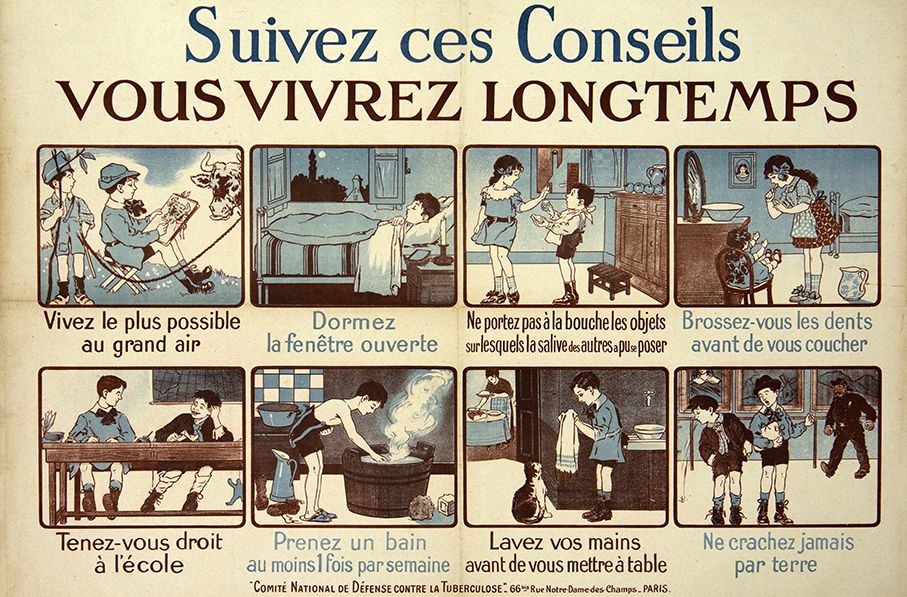SEVILLE / 24 February 2022.
FOLLOW THESE TIPS AND YOU WILL LIVE FOR MANY YEARS, says the French poster at the top of this second post on Healthy Architecture.
We said in the previous post that the COVID-19 pandemic has served as a catalyst to put the relationship between architecture and health at the centre of the debate. For this reason, numerous publications have proliferated that address the problematic connection between the work of a discipline such as architecture and the state of complete physical, mental and social well-being and not just the absence of illness or disease, which is the definition of health adopted by the World Health Organization (WHO). In these circumstances, as a new commercial label intended to sell a product or service, syntagms such as ‘healthy house’ are appearing, in which an artificial and inanimate object is attributed a quality of being alive, human or animal. Even, as a result of the concern with mental health, academic works and books are emerging that relate Neuroarchitecture to mandalas, to Gestalt exercises or to nutrition.
In some cases, these novel approaches are not always based on a solvent body of doctrine to support them; others start from biased premises to lead to ideologically interested conclusions and, finally, there is another set of texts in which it is impossible to understand what they are trying to convey, because the whole discourse is an indecipherable magma covered in quotations, as erudite as they are esoteric. They are contributions that have a certain poshlot character, a Russian word used by Nabokov in 1967 to identify within contemporary narrative what they are: “vulgar clichés, philistinism in all its phases, false depth, imitations of imitations, crude, stupid and dishonest pseudo-literature”. The immediate consequence of the propagation of this type of texts is the great entropy they generate, which, besides producing enormous confusion, hinders the advancement of knowledge.
It is necessary to distance ourselves from this type of recent production and establish, with concrete data and examples, how the physical and environmental surroundings influence people’s wellbeing and quality of life and how they have been decanted from previous experiences. In short, to explain with the courtesy of clarity the genesis of the influence of architecture on the physical, mental and emotional health of the population, which is the objective we have set ourselves in these eight issues of the IUACC bulletin.
The impact of architecture on increasing health has been a long road that began with the hygienist movements of the mid-19th century, born of the social demands caused by the unhealthy urban agglomerations that arose after the Industrial Revolution. From those demands were born new concepts and urban models such as the Garden City or the Linear City.
One of the catalysts for the search for hygienic solutions in buildings at the beginning of the 20th century was the lack, for decades, of effective remedies against diseases such as cholera or tuberculosis. The only things that seemed to work against the latter disease were sunshine, cleanliness and rest, so buildings began to be designed with these aspects in mind as the only palliative solution to the symptoms of the disease, not its cure. Hospitals were built with large windows, sanatoriums with huge terraces, dwellings raised off the ground to escape dampness and streamlined furniture where dust could not settle or harbour germs.
Some authors maintain that, thanks to the visionary approach of the pioneers of the Modern Movement, architecture would become the messianic discipline that periodically remedies crisis situations, purifying buildings and constructions, since cities are nothing more than the consequence of the various epidemics that humanity has suffered over time, because it is the human being who creates the conditions of the disease. This proposition is a polshot that further fuels the contemporary bad conscience of the post-industrial society. With this biased approach it is not surprising that some proposals coming from the architectural discipline are proposed as a new revelation, without which human beings will not be able to subsist. However, the premise on which the above hypothesis is based is false, because the unhealthy environmental contingencies served as programmatic demands for the pioneers of the Modern Movement, but they were not its objective. Their priorities were far removed from providing a direct response to the functional problems arising from a sanitary situation. Their main concern was social and, above all, aesthetic. Their aim was to create a new style. For the architectural avant-gardes of the 20th century, the saving myth of the human being was the machine. Everything had to be subjected to the machine, even artistic creation.
On the basis that all buildings had to meet minimum functional standards, the avant-garde proposed a new architecture that had to be a faithful expression of the use for which it was intended. Their buildings, products and objects were aimed at a single prototype of the individual, the mass-man with homogeneous and equal desires and needs in all parts of the world. With these foundations, architects ended up constructing buildings which, like machines, efficiently solved the functional problems required, but in which it was difficult to accommodate people’s need for emotion, self-recognition or fulfilment.
The concepts of life and death, with their respective emotions of joy and sadness, were excluded from care and health institutions. The consequence was impersonal spaces and overwhelmingly alienating buildings. True to their programmatic principles, healthcare buildings incorporated technical issues such as sanitation, accessibility and safety. They were built on the basis of the symptoms of disease, with medical cure as the only useful factor in healing. This utilitarian approach resulted in hard sterile surfaces, bright and colourless aseptic spaces, artificial ventilation systems, batteries of minimal rooms or long interior corridors isolated from the outside – without natural light, but with lamps hypersensitive to circadian rhythms – made sanitary buildings effective healing factories, but without identity and soul. The emotional component of the user, whether healthy or ill, was rarely considered when experiencing or living in these spaces.
During the reconstruction of Europe, as a reaction to the machine that produced so much destruction during the Second World War, the human being was once again placed at the centre of architectural thought. At the CIAM (Congrès Internationaux d’Architecture Moderne), which took place between 1947 (Bridgwater) and 1956 (Dubrovnik), the conclusion was reached that it was necessary to reconsider the human being as a being endowed with his own identity, with diverse peculiarities that cause a multiplicity of situations and require different environments. At the same time, in 1945, Henry Sigerist, historian and health professional, referred for the first time to the promotion of health and the environment as one of the four fundamental actions in medical care, followed by three other activities such as disease prevention, cure and rehabilitation. This approach, together with the contributions of Lalonde in 1974, was fundamental for the WHO (Ottawa, 1986) to establish that, in relation to the health of the population, there are four determining factors: environmental, social, care and biological/genetic.
This new person-centred perspective brought about by the later CIAMs was a decisive change of vision for architecture. Its assimilation was slow but progressive over time. As we will see in the next instalment, it gradually began to change the way we perceive and understand buildings and the inhabited environments of cities.
—–
Santiago Quesada García is Doctor of Architecture, Professor of the Department of Architectural Projects, Head Researcher of the Healthy Architecture & City group (TEP-965) and Principal Investigator of the projects ALZARQ of the Ministry of Science and Innovation and DETER of the Junta de Andalucía.
Post published in the IUACC Bulletin nº 126 of February 24, 2022
—–
Image of the post:
French poster headed “Follow these tips, you will live longer”, illustrated with eight images with recommendations to avoid contracting tuberculosis. French National Tuberculosis Defence Committee in collaboration with the Rockefeller Foundation, Paris, 1920.


